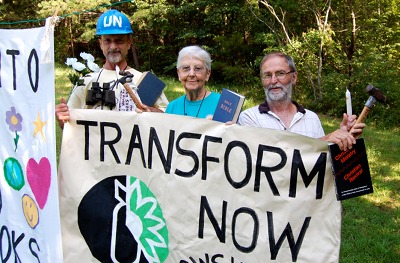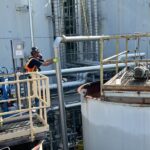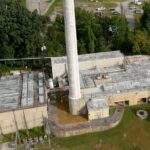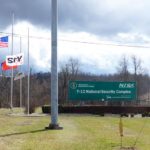
The three anti-nuclear weapons activists pictured above sneaked into a high-security area at the Y-12 National Security Complex on July 28 and triggered a security crisis that has led to personnel changes, a temporary halt in nuclear operations, and a potential termination of a federal contract with B&W Y-12. From left to right, the three protesters are Michael R. Walli, Megan Rice, and Greg Boertje-Obed. (Submitted photo)
Note: This story was last updated at 9:32 a.m. Aug. 15.
Many security cameras weren’t working when three anti-nuclear weapons activists sneaked into the Y-12 National Security Complex early in the morning on Saturday, July 28, a federal official said in a critical letter released Tuesday evening.
One of those cameras was near a fence penetrated by the protesters, who allegedly used bolt-cutters to slice through three fences before they walked to a high-security building known as the Highly Enriched Uranium Materials Facility, where bomb-grade uranium is stored.
The intruders, who allegedly spray-painted slogans and splashed human blood on the HEUMF, set off many alarms in a “multi-layered sensor system” in a fence line, but the Y-12 protective force failed to react, the official said.
When guards alerted by the alarms responded with a vehicle patrol, it took them too long to arrive at the scene, and once there, they “failed to take appropriate steps to take control of the situation,” said the official, National Nuclear Security Administration Contracting Officer Jill Y. Albaugh. She said a responding supervisor finally took control and removed the protesters.
Written Friday, Albaugh’s letter gives Babcock and Wilcox Technical Services Y-12, the plant’s managing and operating contractor, 30 days to show why the federal government should not proceed to terminate its contract.
The letter is called a show cause notice, and it was sent to Darrel P. Kohlhorst, former B&W Y-12 president and general manager. His surprise retirement was announced Friday, one in a series of stunning moves since the unprecedented security breach.
“Our preliminary fact-findings reveal that contributing and direct causes of the security event include an inappropriate Y-12 cultural mindset, as well as a severe lapse of discipline and performance in meeting conduct of operations expectations,” Albaugh wrote to Kohlhorst, who has been replaced by Charles “Chuck†G. Spencer. “I am concerned that such issues may exist in other areas of Y-12 operations—and not just in the security program.”
Her letter assigns preliminary blame to both B&W Y-12 and G4S Government Solutions Inc., the plant’s security contractor that operates as WSI Oak Ridge. She said the plans and procedures for responding to multiple alarms at Y-12 were inadequate, proper measures were not in place to cover the cameras that weren’t working, and there was an unnecessary delay in repairing and replacing cameras.
An NNSA official said late Thursday evening that the cameras have been repaired.
Motivated by their religious beliefs, the protesters allegedly entered Y-12 from a ridge on the north side of the plant on July 28, and they were able to cross the Perimeter Intrusion Detection Assessment System, or PIDAS, that surrounds the 150-acre Protected Area on the west end of Y-12. They traversed an area where deadly force is authorized.
Their ability to get to the fortress-like HEUMF has raised questions about the plant’s highly touted security system and led to a string of personnel changes, including at B&W Y-12 and WSI Oak Ridge. There has also been a temporary halt in nuclear operations, and U.S. Energy Secretary Steven Chu has called the security breach “unacceptable and deeply troubling.”
Albaugh said B&W Y-12 and WSI-Oak Ridge failed to “properly coordinate and integrate” to ensure adequate security at the 811-acre site, which was built during World War II to enrich uranium for the world’s first atomic bombs and is now the nation’s main production facility for many nuclear weapons components.
Other events since the July 28 intrusion, including procedural noncompliance, have demonstrated “a serious breakdown in the security operations at Y-12, including a lack of leadership and significant tactical, procedural, training, and communication deficiencies,” Albaugh wrote.
G4S Government Solutions Inc. was responsible for some of the issues while it was a prime contractor to NNSA, but that doesn’t alleviate B&W Y-12’s contractual obligations, Albaugh said. NNSA’s preliminary findings “indicate that both B&W Y-12 and WSI-OR are in substantial violation of certain subject contract clauses, as well as certain DOE orders, and its own internal procedures and processes.”
In its response to the show cause notice, B&W Y-12 is expected to say what steps it will take to comply and fix problems. Since B&W Y-12 now oversees the protective force part of the WSI-OR contract, B&W Y-12 is also expected to outline the corrective actions for WSI-OR, Albaugh’s letter said.
Investigations of the intrusion by the three protesters—57-year-old house painter Greg Boertje-Obed, 82-year-old nun Megan Rice, and 63-year-old Catholic worker Michael R. Walli—are under way, including one by the U.S. Department of Energy Office of Inspector General.
There’s been talk of a possible furlough for some Y-12 workers, but officials at the site wouldn’t comment except to say no employees had been furloughed as of Monday.
Meanwhile, the activists, who called their intrusion Transform Now Plowshares, have been indicted by a federal grand jury on three counts each of federal property destruction, property depredation, and trespassing. They face an Oct. 10 trial in U.S. District Court in Knoxville.
Walli has said they were at the plant at least two hours, but an NNSA official has declined to comment on the length of time the intruders were at Y-12, where they also reportedly hung banners on the HEUMF, offered bread to guards, and read a statement.
Read a copy of Albaugh’s letter here.





dumbguard says
Security at this site should not be contracted out. D.O.E. uses federal agents to transport special nuclear material, why does it trust private security guards to guard them?
Nuclear says
This is the end result of year after year of budget cuts. A prime example of the failure of the “do more with less” manta we hear everyday. I’ve worked 35 years at Pantex and it’s gotten worse every year, especially since NNSA got involved.
Peggy Tiner says
I can understand why the guards didn’t apprehend the trespassers immediately. Thse old folks were armed with wire cutters, a bible, flowers, bread, human blood, spray paint, posters, and probably praying along with it. The guards are scratching their heads saying “I don’t think the rule book covers this. I’m pretty sure we are allowed to shoot them, but we would probably have to fill out a lot of paperwork if we did.”
Floyd Glenn says
Ihope the fine money is used to repair the PIDAS and hire managers with physical security back grounds.
Floyd Glenn says
For all of you who believe the hype from the likes of Steve Wyatt and Corker, read10 CFR 1047.7. The use of deadly force to stop these intruders was not authorized. If the site managers had complied with security policies and directives, this would not have been an issue. If the PIDAS had been tested to assure its effectiveness it would have worked. Anyone who had knowledge of cameras and alarms not working (and they had knowledge) should have their employment terminated immediately. The intruders should have been in the prone position before they reached the third fence. I am sick of all the lies and excuses from these corrupt people. In the future I will call them out. In my opinion, U. S. Sen. Bob Corker’s not concerned about public safety. He is only concerned about JOBS. Him saying “they were never near anything sensitive” is ludicrous. They were a blown door away from causing a criticality, which could have killed over 60,000 people.
johnhuotari says
That’s the first time I’ve heard anyone claim that deadly force was not authorized, Floyd. I’ll have to look up your citation. Federal officials have said the protesters were in an area where deadly force was authorized and guards could have opened fire.